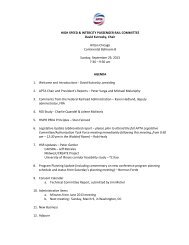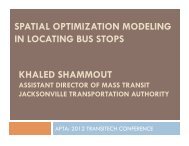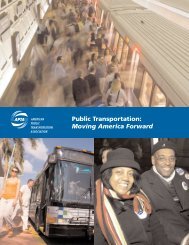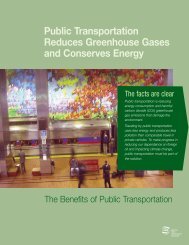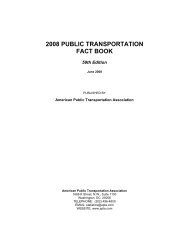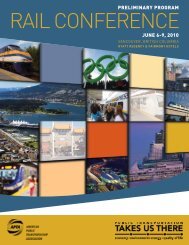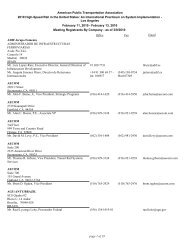2012 APTA Fact Book Appendix A - American Public Transportation ...
2012 APTA Fact Book Appendix A - American Public Transportation ...
2012 APTA Fact Book Appendix A - American Public Transportation ...
You also want an ePaper? Increase the reach of your titles
YUMPU automatically turns print PDFs into web optimized ePapers that Google loves.
<strong>2012</strong> <strong>Public</strong> <strong>Transportation</strong> <strong>Fact</strong> <strong>Book</strong>,<br />
<strong>Appendix</strong> A: Historical Tables<br />
Page 134<br />
using either locomotive hauled or self propelled railroad passenger cars, is generally characterized by<br />
multi-trip tickets, specific station to station fares, railroad employment practices and usually only one or<br />
two stations in the central business district. Intercity rail service is excluded, except for that portion of<br />
such service that is operated by or under contract with a public transit agency for predominantly<br />
commuter services. Most service is provided on routes of current or former freight railroads.<br />
Demand Response is a mode of transit service (also called paratransit or dial-a-ride) characterized by<br />
the use of comprised of passenger automobiles, vans or small buses operating in response to calls from<br />
passengers or their agents to the transit operator, who then dispatches a vehicle to pick up the<br />
passengers and transport them to their destinations. The vehicles do not operate over a fixed route or on<br />
a fixed schedule except, perhaps, on a temporary basis to satisfy a special need; and typically, the<br />
vehicle may be dispatched to pick up several passengers at different pick-up points before taking them to<br />
their respective destinations and may even be interrupted en route to these destinations to pick up other<br />
passengers. The following types of operations fall under the above definitions provided they are not on a<br />
scheduled fixed route basis: many origins-many destinations, many origins-one destination, one originmany<br />
destinations, and one origin-one destination.<br />
Heavy Rail is a mode of transit service (also called metro, subway, rapid transit, or rapid rail)<br />
operating on an electric railway with the capacity for a heavy volume of traffic. It is characterized by high<br />
speed and rapid acceleration passenger rail cars operating singly or in multi-car trains on fixed rails;<br />
separate rights-of-way from which all other vehicular and foot traffic are excluded; sophisticated signaling,<br />
and high platform loading.<br />
Light Rail is a mode of transit service (also called streetcar, tramway, or trolley) operating lightweight<br />
passenger rail cars singly (or in short, usually two-car or three-car, trains) on fixed rails in right-of-way that<br />
is not separated from other traffic for part or much of the way. Light rail vehicles are typically driven<br />
electrically with power being drawn from an overhead electric line via a trolley or a pantograph; driven by<br />
an operator on board the vehicle; and may have either high platform loading or low level boarding using<br />
steps.<br />
Trolley Bus is a mode of transit service (also called trolley coach) using vehicles propelled by a motor<br />
drawing current from overhead wires via a connecting pole called a trolley pole from a central power<br />
source not on board the vehicle.<br />
Vanpool: Ridesharing by prearrangement using vans or small buses providing round trip transportation<br />
between the participant's homes or prearranged boarding points and a common and regular destination .<br />
Data included in this report are the sum of vanpool data reported in the National Transit Database and do<br />
not include any data for vanpools not listed in the National Transit Database. Vanpool service reported in<br />
the NTD must be operated by a public entity, or a public entity must own, purchase, or lease the<br />
vehicle(s). Vanpool included in the NTD must also be in compliance with mass transit rules including<br />
<strong>American</strong>s with Disabilities Act (ADA) provisions, be open to the public and that availability must be made<br />
known, and use vehicles with a minimum capacity of 7 persons.<br />
Other modes of transit service not listed separately on modal tables include ferry boat, aerial tramway,<br />
automated guideway transit (also called personal rapid transit, group rapid transit, or people<br />
mover), cable car, inclined plane, and monorail. Not all of these modes of service are included in<br />
Other on each table; note clarifications in footnotes for modes that are included.<br />
OPERATING DATA - SERVICE SUPPLIED DEFINITIONS:<br />
Average Vehicle Speed is the average speed in miles per hour for vehicle while in revenue service;<br />
calculated by dividing vehicle revenue miles by vehicle revenue hours.<br />
Revenue Service is the operation of a transit vehicle during the period which passengers can board and<br />
ride on the vehicle. Revenue service includes the carriage of passengers who do not pay a cash fare for



